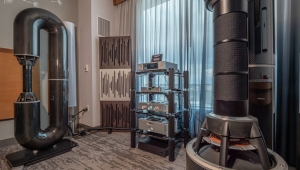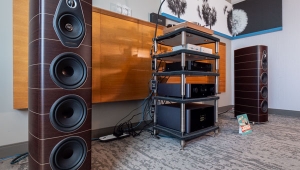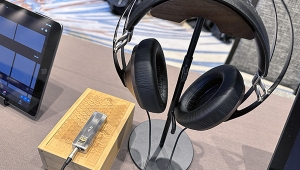| Columns Retired Columns & Blogs |
Working in the Front Line
A committed audio equipment reviewer operates at the front line of audio subjectivity. Working on behalf of a readership made up of consumers thirsting for independent, informed opinion and advice, a reviewer is commissioned by the editor of a magazine to produce reports with a technical and subjective content on a wide range of available audio products. These reviews must be both fair and completed at short notice on a relatively small budget.
Footnote 1: Originally titled "Subjectivity and Hi-Fi Equipment Reviewing for the Consumer Audio Press," this article, in a somewhat different form, was intended to be presented as a paper at the second "Perception of Reproduced Sound" Conference, scheduled to be held in Denmark in the summer of 1990. Unfortunately, the conference was canceled due to lack of interest from potential attendees. A collection of the papers presented at the first, 1987, Denmark conference has been published, however, and is available under the title Perception of Reproduced Sound from Old Colony Sound Lab, P.O. Box 243, Peterborough, NH 03458, for $35 including S&H. (Telephone charge-card orders: (603) 924-6371 or 924-6256.) This collection is essential reading for any audiophile interesting in tying the fields of observation and measurement together.—John Atkinson
How is it possible to do this successfully, when a similar task undertaken by an industrial laboratory or test house would take five times as long, cost ten times as much, and deliver a verdict of arguably poorer relevance (footnote 1)?
Primary responsibility to the consumer
Any reviewer worth his salt is a crusader working in the best interests of the consumer. In a technical field such as high-quality audio, few consumers are fully qualified to judge absolute performance for themselves; if forced to rely on the advice of retail salespeople, they may not be confident of the quality of the advice given.
Equipment critics working for the audio press are therefore vested with a heavy responsibility: to try to produce fair, consistent, accurate opinions for their readers' guidance. On the other hand, they also have a duty to be fair to the designers and manufacturers of the audio equipment they write about. Unfortunately, some manufacturers object violently when expert critics fail to agree with their own opinions. Others, however, accept the situation philosophically, in the generally correct belief that good equipment will win in the end, regardless of occasional reversals or inaccuracies of subjective opinion.
Though we would like to treat equipment reviewing as a scientific process, and many steps have been taken in that direction, fundamentally a review is based on opinion, of which a large proportion is composed of wholly subjective reactions to sound quality.
The role of lab testing
If the reviewer is prepared to spend the money, it is not difficult to set up a sophisticated test laboratory to measure all the standard parameters relevant to an audio unit. It is certainly most helpful to have access to detailed lab reports when writing a review. Indeed, such reports are essential if erroneous conclusions are not to be drawn concerning sound quality. Some of the commoner pitfalls which can trap the unwary subjective critic include errors in the RIAA de-emphasis characteristic found in the phono cartridge inputs of preamplifiers and integrated amplifiers. The equalization is complex, involving three time constants generating nearly 40dB of compensation over the 20Hz-20kHz audio band. I have found mild turnover and slope errors to be surprisingly common, and these can dominate the subjective response to the reproduced sound. In fact, one of the greatest difficulties concerns the mental separation of underlying quality characteristics from first-order errors such as frequency-response aberrations and channel imbalance.
Subjective effects of first-order errors
Slight errors in channel balance, either in specific frequency ranges or in overall level, can subtly disturb one's opinion of the sharpness of stereo focus. Statistically well-controlled testing has not only confirmed the audibility of absolute phase/polarity but also that of level differences as little as 0.2dB. These differences may be of octave or several-octave bandwidth, with a sensitivity of a similar magnitude. The subjective responses to variations in amplitude/frequency response are pretty well documented; the careful reviewer bears these constantly in mind. For example, less than 0.5dB—5%—of treble lift in the 3-10kHz range can give rise to a mildly increased sense of immediacy, transparency, and liveliness without necessarily being directly obvious as treble lift. A similar degree of loss in the 150Hz-400Hz range can make a vocalist appear lightweight and lacking in power in the fundamental range, lending a crisper quality to the sound. This might be preferred on one recording but disliked on another.
Footnote 1: Originally titled "Subjectivity and Hi-Fi Equipment Reviewing for the Consumer Audio Press," this article, in a somewhat different form, was intended to be presented as a paper at the second "Perception of Reproduced Sound" Conference, scheduled to be held in Denmark in the summer of 1990. Unfortunately, the conference was canceled due to lack of interest from potential attendees. A collection of the papers presented at the first, 1987, Denmark conference has been published, however, and is available under the title Perception of Reproduced Sound from Old Colony Sound Lab, P.O. Box 243, Peterborough, NH 03458, for $35 including S&H. (Telephone charge-card orders: (603) 924-6371 or 924-6256.) This collection is essential reading for any audiophile interesting in tying the fields of observation and measurement together.—John Atkinson
- Log in or register to post comments




































